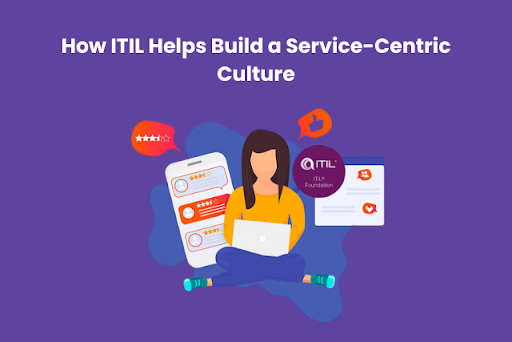
The concept of a service-centric culture has gained prominence in business. Organizations that prioritize service excellence are better equipped to meet customer expectations and stay competitive. One powerful framework that plays a pivotal role in cultivating a service-centric culture is ITIL, or Information Technology Infrastructure Library. In this blog post, we’ll explore What is ITIL and how it helps build a service-centric culture within organizations.
What is ITIL?
One comprehensive framework for IT service management is the IT Infrastructure Library (ITIL). Companies may improve and standardize their IT service management processes using the UK government’s IT Infrastructure Library (ITIL) architecture. The latest ITIL version, ITIL 4, incorporates modern techniques and concepts to keep up with the rapid changes in today’s business environment.
Building a Service-Centric Culture with ITIL
With IT Infrastructure Library (ITIL) defined, we can move on to how it fosters a service-centric culture in businesses.
Customer-Centric Approach
The provision of customer value is given significant weight in ITIL. The whole system is geared toward learning about and satisfying client requirements. By adopting ITIL practices, businesses may realign their IT services with the company’s overall objectives and concentrate on improving customer happiness. The establishment of a service-oriented culture relies heavily on taking this kind of customer-first approach.
Standardized Processes
The ability to standardize IT service management procedures is a crucial part of any culture, and this is exactly what ITIL offers. ITIL provides a systematic framework for creating and implementing uniform rules and best practices for service management throughout an organization. This regularity not only raises the bar for customer satisfaction but also fosters an atmosphere where workers are more likely to comprehend and adhere to predetermined procedures.
Continuous Improvement
Iterative testing and improvement (ITIL) was founded on this principle. Cultures that place a premium on providing excellent customer service will find this concept to be a natural match. Methods for identifying and executing IT infrastructure improvements are outlined in the IT Infrastructure Library (ITIL). Among these methods are incident management, change management, and service enhancement.
Collaboration and Communication
Organizational departments and teams must work together without any hitches if they want to foster a service-centric culture. IT Infrastructure Library (ITIL) fosters teamwork by removing barriers and opening lines of communication across departments. By working together, we can be confident that everyone is contributing to our ultimate aim of providing first-rate service. ITIL’s emphasis on procedures like service transition and service design encourages teamwork in this way.
Transparency and Accountability
A service-oriented culture should emphasize openness and responsibility. With the use of ITIL, defined roles and responsibilities for service management can be established. This specificity improves understandability and promotes responsibility for service provision. Transparency is easier to get with the help of ITIL’s best practices, like service level management and service catalog management.
Change Management
Given the dynamic nature of the modern corporate landscape, adaptability is a cornerstone of creating a service-centric culture. ITIL’s change management process makes sure that adjustments to IT services and systems are well-thought-out, evaluated, and communicated in order to keep downtime to a minimum. Organizational cultures that see change positively as a chance to advance may be fostered via careful change management.
Data-Driven Decision-Making
Information is highly prized in today’s service-based society. IT Infrastructure Library (ITIL) advocates for the use of data for analysis and decision-making. Organizations may analyze the efficacy of their IT services and pinpoint problem areas with the use of metrics and key performance indicators. IT Infrastructure Library (ITIL) procedures like service reporting and measurement are compatible with this data-driven strategy.
Conclusion
IT Infrastructure Library (ITIL) is an effective methodology for encouraging a service-oriented mindset inside an organization. ITIL aids businesses in changing their service management practices and, by extension, their ethos by emphasizing customer-centricity, standardization, continuous improvement, and cooperation. In addition to improving the quality of IT services, adopting ITIL best practices guarantees that a service-centric culture will become deeply embedded in the fabric of the organization. This mental change helps people achieve their goals, and remain flexible.



